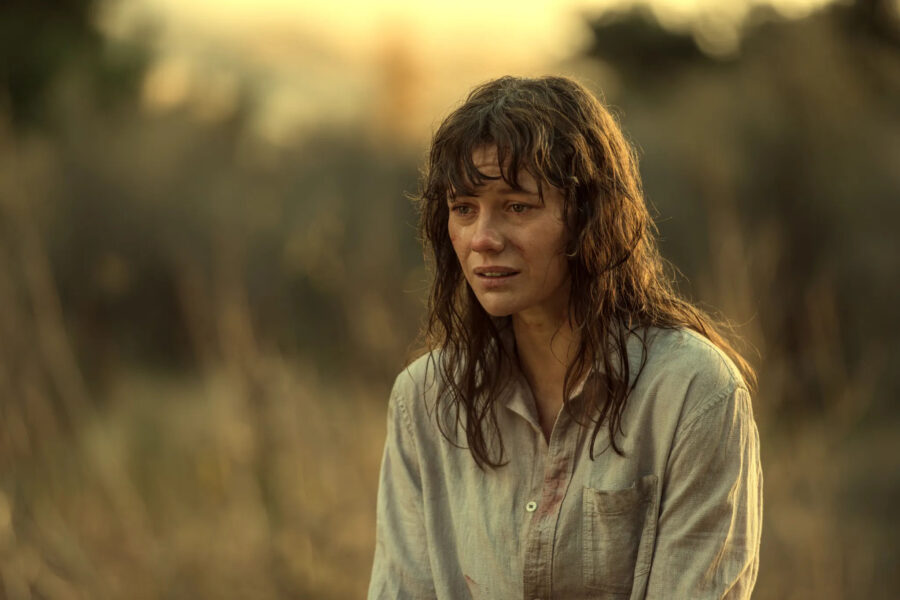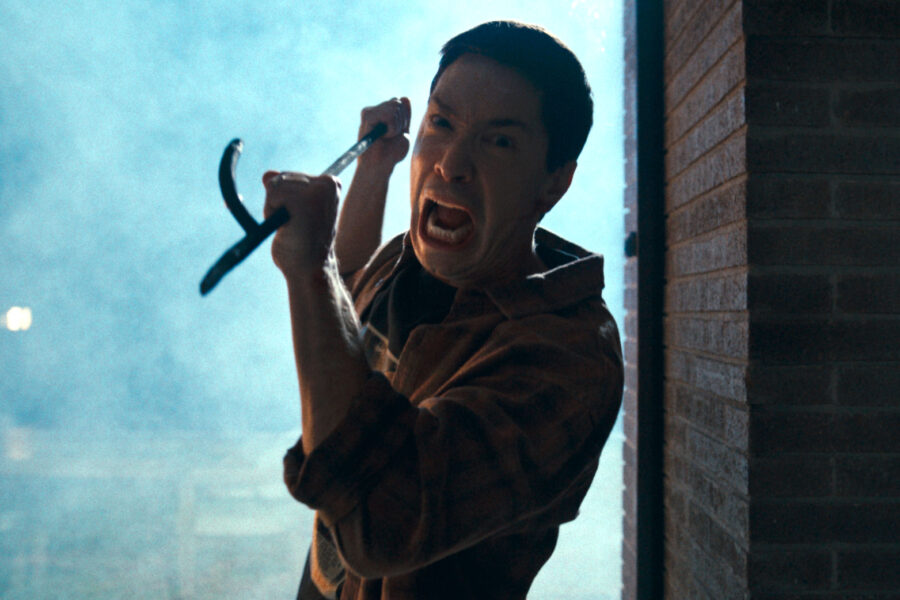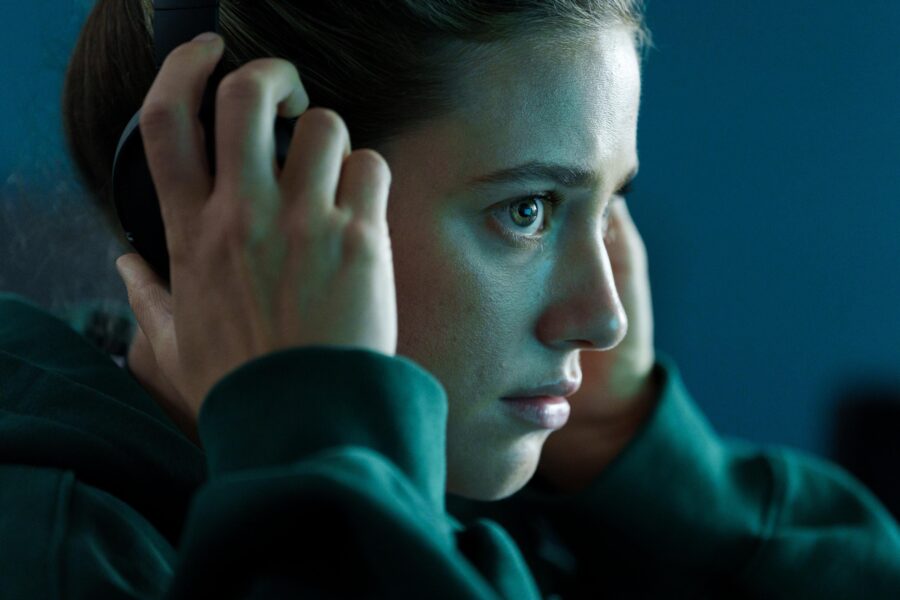
Set in 2004, Iranian teenager Yasamin AKA Yasi (Rose Dehgan) has just moved to Canada with her dad, Ali (Ashkan Nejati), and grandma, Zoreh (Maryam Sadeghi), following her mother’s dealing some years prior. Nervous about starting a new school, Yasi sits watching her favourite sitcom, repeating the English dialogue, often at the same time as the characters. When her dad asks for help unpacking boxes, Yasi says she’s busy, but her dad isn’t buying it. “If my English sucks, the other kids are going to laugh at me,” she explains. A flashback shows a younger Yasi talking to her mother, a faceless blonde woman. They’re practising how to say “foreigner” in English. “That was perfect,” her mother says. “Keep practising so we can make your English strong and keep any demons away from you.” This is a huge theme in Ava Maria Safai’s Foreigner, which had its world premiere at Fantasia Festival last night. Are the demons a metaphor for racists or for betraying your native culture?
At school, Yasi quickly meets Queen Bee Rachel (Chloë MacLeod, Sugar Rot) and her followers, Emily (Victoria Wadell) and Kristen (Talisa Mae Stewart, The Casket Girls). They sit in front of her in a triangle, eerie grins painted across their faces à la Smile. It doesn’t take long before they ask Yasi where she’s from. “Isn’t that, like, a third world country?” they ask of Iran. “So you’re a refugee, then?” The score is effective here, sinister music emphasising Yasi’s growing discomfort towards their underlying racism which they believe is innocent curiosity. Foreigner explores the immigrant experience through a pastiche of coming-of-age and horror narratives, with this scene in particular referencing the scene in Mean Girls—also set in 2004—where Karen (Amanda Seyfried) says to Cady (Lindsay Lohan), “So if you’re from Africa, why are you white?”
Yasi and her family often talk about the racism she experiences. When she recounts Rachel asking if they’re allowed to have boyfriends in Iran, Zoreh says, “Do they think we’re nuns? Virgins?” This further highlights common misconceptions about Iran and the absurdity in it. Meanwhile, her dad is more understanding, but perhaps he can stand to be because he’s a man. “Have some more sympathy,” he says. “They don’t know any better.” This reflects the prevalence of misinformation spread by the news and media which perpetuate and reinforce the often racist beliefs and genuine curiosity white people develop towards races outside of their own. Ali and Zoreh surround Yasi with healthy attitudes towards her Iranian culture and identity, especially when it comes to being judged by others. Her dad says it doesn’t matter what other kids think of her because she isn’t going to remember them when she graduates, meanwhile Zoreh tells her a parable about not fitting in and learning to love yourself and your place in the world. But these earnest attempts hardly matter when you’re a teenager faced with the real doom of being an outcast. Without a mother to guide her, Yasi doesn’t have anyone to relate to.

Safai’s sophomore feature provides compassionate commentary on the experience of being a foreigner, especially by showcasing the cultural differences between Iran and Canada. The film being split into Persian (Farsi) and English dialogue makes it more realistic by immersing us further into the foreign experience. Afraid of being made fun of for eating brightly coloured, aromatic food, Yasi turns down her grandma’s tasty, hearty, and nutritious stew in favor of a bland sandwich from the school’s cafeteria. Having never met an Iranian person before, Rachel and her followers develop an intense interest in Yasi, seeing her as a project with the end goal of assimilating her into white Canadian culture. When presented with the idea of dyeing her hair blonde, Yasi can’t resist. After all, blonde hair is everywhere—her friends, her favourite sitcom, the adverts on television, and even her own mother. But with Yasi rejecting her own culture in order to fit in, the loss of her Iranian identity attracts a demonic force that threatens to destroy her.
Dehgan delivers a sensitive and powerful performance as Yasi, while MacLeod, Wadell, and Stewart are genuinely unsettling as the well-meaning popular girls. By leaning into the horror genre (with some surprise body horror), Safai was able to amplify the psychological impact that casual racism and social pressures have on Yasi. Her assimilation into white culture bores into her like a disease as the lines between nightmare and reality become blurred.
Visually, Foreigner embodies its 2004 setting with bold colour grading and striking costume and production design, featuring lava lamps, butterfly clips, teen magazines, and an approximation of 2000s fashion. Rachel tends to wear a central color like pink or purple, while Emily and Kristen match behind her in blues. These colourful details are memorable and create a unique visual palette in addition to evoking nostalgia for that era. The time period also captures a distinct social and cultural landscape; a time when pop culture played a significant role in shaping people’s ideas about belonging. Brands were selling not just products, but lifestyles. Sitcoms showcased a place to belong within strong friendship groups. Movies both critiqued and reinforced the pressure to fit into a certain group. The overall messaging was conflicting: be yourself but also conform to a conventional standard or group. Foreigner, then, is a welcome entry into 2000s coming-of-age horror as it reminds us that wanting to fit in is a very human desire, but it should not come at the cost of losing who we are.




Leave a Reply